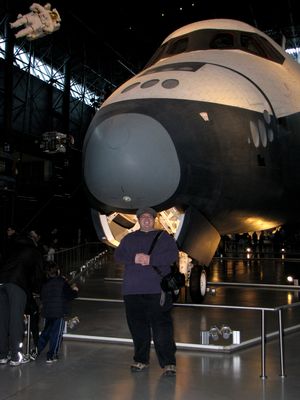Go for main engine start… 3… 2… 1… we have booster ignition, and liftoff!
6 minute read
April 23, 2011, 10:58 PM
One of the fun things about living in the DC area is the fact that you have the Smithsonian Institution right in your backyard. Of course, it’s not like DC area locals go there on a regular basis. We don’t. But when I have guests over, I have a place to take guests that’s fun and educational. And in the case of this weekend, I hosted Mom from Thursday evening to Saturday afternoon, and on Friday, we went to the Smithsonian’s Udvar-Hazy Center out by Dulles Airport. The goal: see the Space Shuttle Enterprise before they swap it out for Discovery.
Let’s admit – I’m a bit of a space nerd. I just got finished reading a couple of books about the history of human spaceflight, and have edited quite a few articles on spaceflight-related topics on Wikipedia. I’ve never seen a rocket launch in person (but would like to one day), and I think actually flying in space might be fun, but launch and landing kind of scares me.
And the Space Shuttle, the technological marvel of its time, though in practice seriously flawed in its design, was interesting to see live and in person. First of all, photos do not quite give you a good idea about what the scale of this beast is. In looking at Enterprise (the prototype orbiter used for atmospheric testing that never flew in space), what you find out is that parts of the shuttle are a lot bigger than one would think. But at the same time, a lot of the shuttle is a lot smaller than one might think.
On things that are bigger than one would expect, the front of the orbiter kind of struck me as being larger than expected:
For some reason, this just kind of struck me as “wow”. Likewise, it surprised me to see the size of the orbiter’s lettering:
Think about it – the “Enterprise” lettering looks small in photos. But when you’re up close to it, you can really see that the capital “E” is easily three feet tall on the side of the orbiter. And the capital letters in “United States” are easily six feet tall. It really doesn’t look it in NASA photos (e.g. this one), but when you’re on it, the large size of the artwork is noticeable.
Also, I don’t know if you can see it in the second photo, but Enterprise sports the NASA “worm” logo on the wing, which was initially fitted on Challenger, Discovery, and Atlantis. Columbia never wore the “worm” logo on its wing, going from its original unique lettering straight to the “meatball“. Then apparently, Enterprise never got the “meatball” unlike all the other orbiters (sans Challenger).
Additionally, the size of the main engines (replicas in the case of Enterprise) and OMS engines amazed me. You could easily sit inside one of the OMS engine nozzles, and could comfortably pitch a tent inside one of the main engine nozzles. To give an idea of scale, here’s my mother standing underneath Enterprise‘s body flap, showing the main engines:
Then as far as small size, a few things surprised me. First of all, the crew cabin was a lot smaller than I expected. I remember reading somewhere that during STS-1, the astronauts were impressed by the large size of the crew cabin. But to me, it looked like a small space in which to stuff seven people. I’ve circled the crew cabin area:
Since you can’t go in and tour Enterprise‘s interior, we’ll just have to go with that impression, but it looks bigger on television and in photos. Then there are the wings and the underside:
Again, the wings and the underside look a lot bigger on television and in photos. The wings actually look kind of stubby in real life, and I really thought that the shuttle would be wider in back than it turned out to be. It actually seemed small back there.
Otherwise, I’d like to know something. What happened here?
This is the leading edge of the left wing, and I believe this is the area where they tested the reinforced carbon-carbon surface after the Columbia accident. I believe that this photo corresponds with the same area after NASA patched it up after they were finished testing it. Can someone confirm my suspicions? [Edit: It is.]
I also took some time to look at the other spacecraft in the room. This is where you start to appreciate how large the Space Shuttle really is, even though the crew cabin looks kind of small. See, this is a Gemini craft:
Now that is small. See, compared to the Space Shuttle, the Gemini craft is a sardine can. And they put two people in there for days at a time. There’s no room in there to so much as turn around, it seems. I was really surprised at exactly how small these early spacecraft were, and that made the fact that astronauts were in there for days at a time all the more amazing. And note the lack of a bathroom. I can understand being able to pee in your spacesuit, since, without getting into too much detail here, all the Gemini astronauts were men, and it’s fairly easy to accommodate the male version of the species for that kind of need, plus collection of the result seems easy enough. But what about “number two”? What happens when the astronaut inevitably has to poop? I know. Gross. I’m kind of fascinated and disgusted by it all at once – fascinated to think about what they engineered to deal with that, but at the same time, it is a rather nasty bodily function, and I don’t really want to think too hard about how these early astronauts took a dump in space, because it’s kind of gross. I’d prefer to pretend that these astronauts had superhuman strength and never had to go to the bathroom during the flight, but you know how it is… everyone has to go at some point.
But at least the Space Shuttle was equipped with a commode, complete with thigh bars to keep astronauts from floating off while attending to things.
Moving along, though, here I am standing at both ends of Enterprise:
So all in all, Mom and I had fun at the Udvar-Hazy Center. I think I spent a good two hours and some change in the space wing all by itself. However, if we’d stayed a little longer, we might have missed rush hour, which would probably have been a good thing. We got on the Beltway, and it was wall-to-wall traffic. We ended up going an amazingly circuitous route to get back to Maryland, due to a couple of accidents on the Beltway. Normally, we would just zip around via the Beltway from I-66 to Georgia Avenue, but for this, we escaped the Beltway at Tysons Corner, and took Route 123 (Chain Bridge Road) to the Chain Bridge. Then we took Canal Road NW (yes, we were in DC) to Arizona Avenue NW and around a couple of other streets, and then finally to Western Avenue. We followed Western all the way up to Connecticut Avenue, and home from there. Highlights of our unexpected detour included seeing large houses with gated driveways(!) as we approached the Chain Bridge, which Mom and I both thought was a bit pretentious, and also driving on Western Avenue and noticing how the street signs and such are different on both sides of the street since Western Avenue forms the western boundary between DC and Montgomery County. I also pointed out to Mom that the folks on the left side of the street (MoCo side) had a congressman and two senators, while the folks on the right side of the street didn’t have voting representation in Congress (see, a single non-voting delegate doesn’t cut it when DC is, for all intents and purposes, a state).
So there you go, I suppose. One space shuttle, and then a circuitous trip home.
Web site: Doing major upgrades to Columbia. Pretty cool.
Song: Enterprise performing an atmospheric test. Does anyone know what the purpose of that needle on the nose was? It was not present at the museum, nor did it make its way to the other orbiters.
Quote: And by the way, if anyone was wondering why Enterprise was chosen for a name, your suspicions are absolutely correct. It is indeed named after the Starship Enterprise from Star Trek, beating out Constitution.










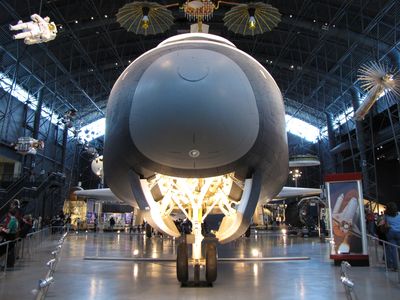
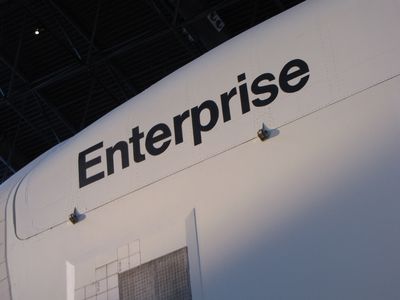
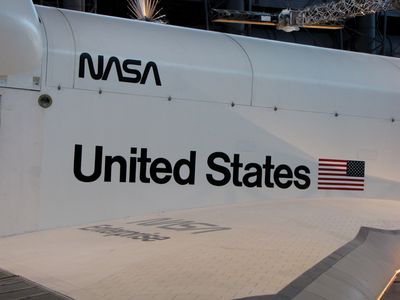
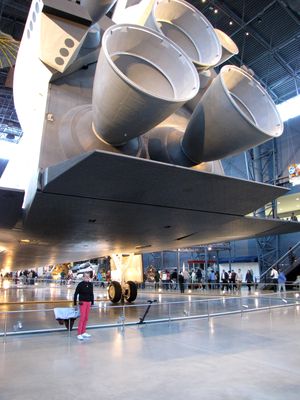
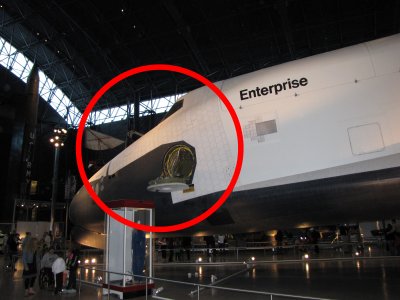
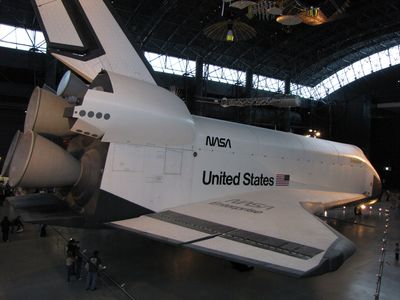

![This is the leading edge of the left wing, and I believe this is the area where they tested the reinforced carbon-carbon surface after the Columbia accident. I believe that this photo corresponds with the same area after NASA patched it up after they were finished testing it. Can someone confirm my suspicions? [Edit: It is.] This is the leading edge of the left wing, and I believe this is the area where they tested the reinforced carbon-carbon surface after the Columbia accident. I believe that this photo corresponds with the same area after NASA patched it up after they were finished testing it. Can someone confirm my suspicions? [Edit: It is.]](https://files.schuminweb.com/journal/2011/udvar-hazy-08.jpg)

